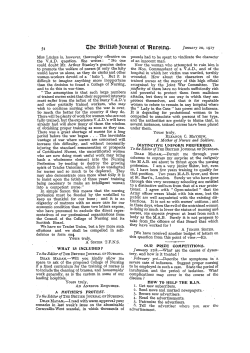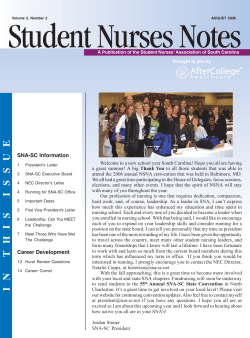
The Future of Nursing: Leading Change, Advancing Health
The Future of Nursing: Leading Change, Advancing Health A Report from the Institute of Medicine (IOM) and the Robert Wood Johnson Foundation Health reform demands a system that is evidence-based, cost-effective, and offers the highest quality of care. New models of care delivery must be innovative in order to attain these goals, and the team of health professionals providing this care must be highly-educated and possess advanced skills. This new paradigm presents a unique opportunity for the nursing profession to fill new leadership positions and leverage its strengths in team-based roles. AACN is committed to using our expertise, data resources, and extensive network of nurse educators to advance the IOM recommendations to better meet the health needs of the nation. The four key messages that structure the recommendations in the Future of Nursing report include: Registered Nurses (RNs) should practice to the full extent of their education and training; scope of practice limitations should be removed. Nurses should achieve higher levels of education and training through an improved education system that promotes seamless academic progression. Nurses should be full partners with other healthcare professionals in redesigning health care in the United States. Effective workforce planning and policy making require better data collection and an improved information infrastructure. As the national voice for baccalaureate and graduate nursing education, AACN is particularly interested in the following IOM recommendations that will require a collaborative response. Increasing the number of nurses with baccalaureate degrees from 50% to 80% by 2020 and encouraging nurses with associate degrees and diplomas to enter baccalaureate programs within five years of graduation. For the past decade, nursing research has provided the evidence that education does make a difference in clinical practice. These studies demonstrate that nurses who hold a baccalaureate degree have better patient outcomes such as lower mortality and failure-to-rescue rates. Additionally, the research indicates that nurses with a Bachelor of Science in Nursing (BSN) are more proficient in their ability to make nursing diagnoses and evaluate nursing interventions as well as demonstrate improved professional integration and research/evaluation skills. According to the 2008 National Sample Survey of Registered Nurses, while the number of diploma graduates has decreased, the number of associate degree graduates is on the rise. The trend in graduates from baccalaureate programs is also increasing, but not at a rate that would meet the IOM’s recommendation. Among the 1.4 million RNs whose initial nursing education was an associate degree, only 12.1% received a BSN and only 5.2% received a master’s or doctorate in nursing, demonstrating the challenge of meeting the IOM recommendation. Percentage of RNs by Highest Education Level: 2000-2008 36.1 34.7 34.5 34.3 36.8 32.8 22.4 17.8 13.9 10.3 Diploma Associates Baccalaureate 2000 2004 To achieve the IOM’s recommendation, the federal government must invest in career ladder programs and support for baccalaureate students through funding programs like the Nursing Workforce Development programs (Title VIII, Public Health Service Act). 13.2 13.2 Master's/Doctorate 2008 US Department of Health and Human Services, Health Resources and Services Administration. (2010). 2008 National Sample Survey of Registered Nurses. Rockville, MD. Doubling the number of nurses with a doctorate by 2020. According to the 2008 National Sample Survey of Registered Nurses, only 0.93% of the RN population has a doctoral degree. Despite the growth over the last four years in the number of nurses whose highest educational level was a doctorate, the increase is insufficient given the IOM recommendation. Currently, there are 234 doctoral nursing programs in the country and an additional 145 programs plan to open. As reported in AACN’s 2011-2012 Enrollment and Graduations report, there were 14,001 students enrolled in doctoral programs and 2,196 graduates. Due to issues such as a faculty shortage, budget cuts, and a lack of clinical sites, schools of nursing turned away 1,156 qualified doctoral applicants in 2011. Doubling the number of nurses with doctoral degrees in the next 10 years will require a concerted effort from stakeholders to address all educational barriers that prevent nurses from obtaining their terminal degree. Percentage of RNs with Doctoral Degrees 2000-2008 3,500,000 3,000,000 3,063,162 2,909,357 2,694,540 2,500,000 2,000,000 1,500,000 1,000,000 500,000 0.64% of the RN population 17,256 0.93% of the RN population 0.90% of the RN population 26,100 28,369 0 2000 2004 Number of RNs with a Nursing Doctorate 2008 Number of RNs US Department of Health and Human Services, Health Resources and Services Administration. (2010). 2008 National Sample Survey of Registered Nurses. Rockville, MD. The demand for faculty, researchers, and Advanced Practice Registered Nurses signals a national call to remove barriers that prevent nurses from obtaining doctoral degrees. To achieve this IOM recommendation, increased funding for scholarships and loan repayments for full-time doctoral students, like those authorized through Title VIII, is critical. Moving to have at least 10% of baccalaureate program graduates enter master’s or doctoral degree programs within five years of graduation. On average, nurses complete their doctoral degree at the age of 46, which significantly shortens their faculty or research career as the average age of retirement is 62.5. While other professionals work 30-40 years after receiving a doctoral degree, nurses only have about 20 years to continue working. This is due in part to two factors. First, the median time between a master’s education and when a nurse begins his or her doctoral program is 15.9 years, as compared to 8.5 years in other disciplines. Second, according to a 2005 report from the National Research Council, a doctoral nursing student will take, on average, 8.3 years to complete their degree, while other doctoral students take 6.8 years to finish. The expanded time frame is a result of the majority of nursing students attending school part-time. Table 2-5. Average Years Between Completion of Initial and Highest Nursing Degrees* Initial Nursing Education Diploma Associate Bachelor’s Bachelor’s 10.5 7.5 – Master’s Doctorate 13.9 11.5 8.2 15.6 12.5 12.4 *Average years between diploma and ADN not calculated due to larger than average rates of missing data. – Too few cases to report estimated percent (fewer than 30 respondents). Source: 2008 National Sample Survey of Registered Nurses To achieve this IOM recommendation, fast-track nursing programs such as BSN to master’s and BSN to doctoral programs must be funded and encouraged. Embedding leadership development into nursing education programs and increasing the emphasis on interdisciplinary education. The future healthcare system must include high-quality, cost-effective care that is delivered by a team of qualified health professionals who are utilized to the full scope of their education and training. This will depend on many factors, one of the most critical being the adequate supply of health professionals. To achieve this end, there must be an increased investment in the right mix of highly educated providers, including nurses who are prepared to fill clinical and leadership roles. The correct mix and team-based approach will create a patient-centered system in which the providers complement each others skills and knowledge. Therefore, education of health professionals will need to be integrated where team-based learning occurs during clinical education. This IOM recommendation can be achieved by funding inter-disciplinary programs like those under the Health Professions Education programs (Title VII, Public Health Service Act) and the Title VIII programs. Faculty Vacancy Rate by Region in Schools Reporting Vacancies for Academic Year 2010-2011 Addressing the faculty shortage by creating salary and benefits packages that are market competitive. A significant faculty shortage in the United States has hindered growth in the nursing workforce. According to AACN’s report on 2010-2011 Enrollment and Graduations in Baccalaureate and Graduate Programs in Nursing, U.S. nursing schools turned away 75,587 qualified applicants from baccalaureate and graduate nursing programs in 2010 primarily due to an insufficient number of faculty. A total of 1,088 vacant positions were recently reported in AACN’s Special Survey on Vacant Faculty Positions for Academic Year 2011-2012, a 24% increase compared to last year. Of those vacant position, 603 of those positions requiring a doctoral degree and 337 preferring a doctoral degree. A prime contributor to this shortage is higher compensation in clinical and private-sector settings, which is luring current and potential nurse educators away from teaching. According to the American Academy of Nurse Practitioners, the average salary of a nurse practitioner, across settings and specialties, is $91,310. By contrast, AACN reported in March 2011 that master's prepared faculty earned an annual average salary of $72,028. Federal stakeholders can help address this IOM recommendation by continuing to fund such programs as the Nurse Faculty Loan Program (authorized under Title VIII) that provides reimbursement of educational loans for the student’s commitment to teach for four years after graduation. Enhancing new nurse retention by implementing transition-into-practice nurse residency programs. Since March 2000, the University HealthSystem Consortium (UHC) and AACN have worked to develop strategies to address the nursing shortage, as well as enhance the expertise of the nursing workforce, to reduce practice errors, and to minimize the burnout caused by stress faced by nurses entering the profession. A study by Casey and Fink (JONA) found that new graduates have difficulty adjusting to their roles in the acute care setting and are often not supported by preceptors and others providing orientation and training. A study by the National Council of State Boards of Nursing (2002) found that healthcare employers perceive that newly licensed RNs are not fully prepared to perform common tasks in a basic practice setting. Recognizing these challenges, UHC conducted a study (2000) to find out what additional support was being offered to new graduate nurses employed in UHC hospitals. Eighty-five percent of the respondents indicated that they had an extended program to prepare new graduates to become competent practitioners; however, the survey showed that there was no uniformity to these programs. The study showed that additional training and support for new nurses is needed to improve job satisfaction, reduce turnover, and enhance skills critical to patient safety. The UHC/AACN Nurse Residency Program is built on evidence-based curriculum that meets national accreditation standards. This proven program has evaluated retention, with most recent data showing an impressive retention rate of 95.6% for the first year of employment, which is significantly higher than the national average (72.9%). Outcomes data also demonstrate resident improvement in confidence, competence, ability to organize and prioritize, communication, leadership, and a reduction in stress levels.
© Copyright 2025











![Registered Nurses [RN]](http://cdn1.abcdocz.com/store/data/000164666_1-a3d85b7677bf9815372c7923ad658fc3-250x500.png)









